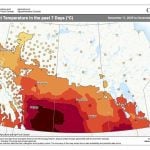I don’t know about you, but this year just seems to be flying by. I can’t believe it is already April. The weather question that seems to be on almost everyone’s mind is: when will spring finally arrive? Well, before we can try to answer that question by looking at the medium- to long-range forecasts, we will have to do our usual look back at last month’s weather numbers to see just how cold or warm March was and see if any of the forecasts were able to get it right.
Read Also

Farmer gift idea: How about a weather station?
The 2025 holiday season is looming, and a home weather station might make a great Christmas gift for farmers
Before we look at the numbers, I thought we should look at the state of polar sea ice coverage, as the winter maximum looks to have occurred in the Arctic and the summer minimum in the Antarctic. Down south, ice cover around Antarctica hit a record-low minimum this year. According to the National Snow and Ice Data Center, for the first time since satellite records began in 1979, the amount of sea ice surrounding Antarctica fell below two million square kilometres, bottoming out at 1.92 million square km on Feb. 25. This record was 190,000 square km below the previous record set in 2017. Moving north into the Arctic, this region appears to have reached an early maximum, also on Feb. 25, when sea ice extent hit 14.88 million square km. This was 770,000 square km below the 1981-2010 average, placing it as the 10th-lowest year on satellite record. The maximum extent data of Feb. 25 was the second-earliest date for the maximum, with the earliest recorded maximum occurring on Feb. 24 in both 1987 and 1996. This is about half a month earlier than average.
OK, on to just how warm or cold March was. Beginning in Alberta, mean monthly March temperatures were not that bad. All three of the main reporting stations (Calgary, Edmonton, Peace River) reported near- to above-average temperatures in March. Calgary was the warm spot (both actually and relatively) with a mean monthly temperature of 0 C, which was about 1.6 C above average. Along with mild temperatures came below-average precipitation, with amounts ranging from just a couple of millimetres below average in Edmonton to over 11 mm below average in Calgary.
The warm air in March looks like it was confined to Alberta. As we move east into Saskatchewan the mean monthly temperature for March fell below average, with both Regina and Saskatoon coming in about 1.5 C colder than average. Precipitation was near average in Saskatoon but well-below average in Regina.
As we all know, the cold March weather continued into Manitoba where all three reporting stations saw mean-average temperatures that were below the long-term average. Both Dauphin and Brandon reported mean monthly temperatures of about -7.6 C, which is 1.5 C below average. The cold spot was Winnipeg, which reported a mean monthly temperature of -8.4 C, which was 2.6 C below average. Usually, the Winnipeg region is the warmer part of the province, but in the spring, it is not unusual for this region to be colder because of its lower elevation, heavier snowpack, and distance from the early-spring warmth trying to bubble up from the U.S. Precipitation during the month was below average across all three regions, with Dauphin and Brandon reporting about nine to 10 mm or about a third the average. Winnipeg saw about 15 mm, which was a little shy of half the average March amount.
Who called it?
For Manitoba and the southern half of Saskatchewan this was a cold and relatively dry March. Looking back at the different long-range forecasts, it looks like none of them were able to get both the temperature and precipitation part of the forecast correct. The closest were both the CFS and the CanSIPS models, which called for below-average temperatures and near-average precipitation.
Now, on to the latest medium- to long-range forecasts — starting off with the almanacs, which don’t change their forecasts once they have been issued. The Old Farmer’s Almanac is calling for April to be very warm, with near-average precipitation, and May will be warm and wet. The Canadian Farmers’ Almanac appears to call for a cold and wet April, with May seeing near- to slightly below-average temperatures along with near-average precipitation.
Looking at the different computer models, NOAA’s three-month outlook continues to call for equal chances of seeing either above- or below-average temperatures and precipitation. The CFS model calls for near-average temperatures in April, warming to slightly above average in May with precipitation expected to be above average in both months. The latest forecast from the last model, the CanSIPS, calls for below-average temperatures and above-average precipitation in April, followed by more below-average temperatures in May, with near-average precipitation.
Last on the list is my forecast. I am going to mostly go with the CanSIPS forecast, with below-average temperatures in April along with above-average precipitation. I still think May will see temperatures warm to above average, with precipitation coming in right around average. Now all we have to do is sit back and see what Mother Nature will throw at us next.
















